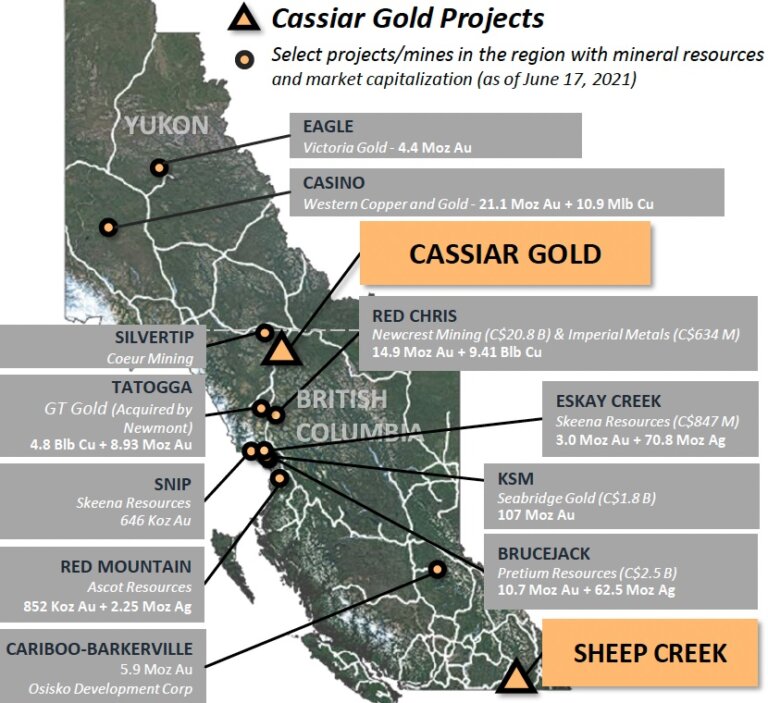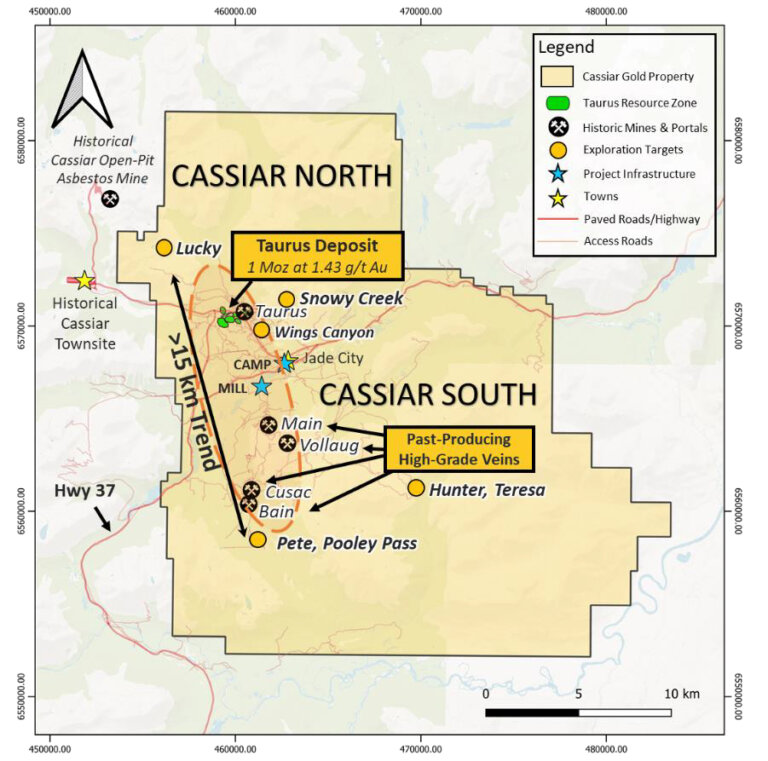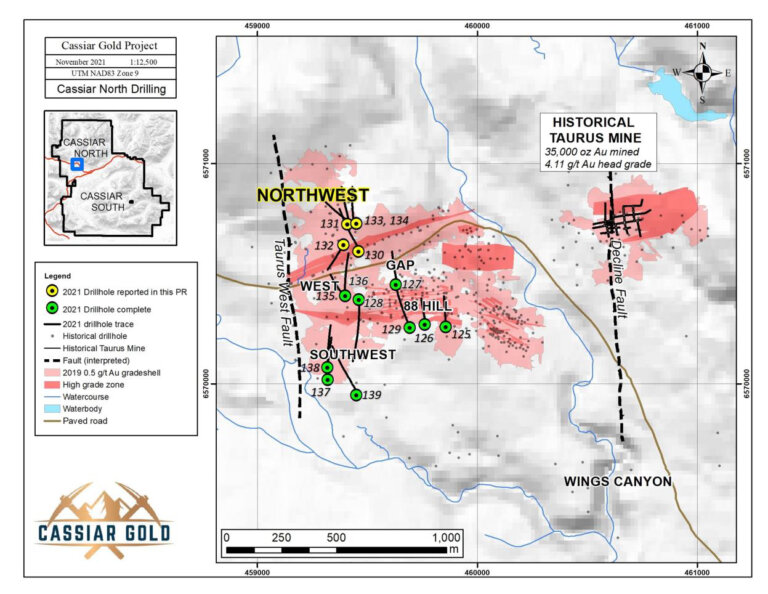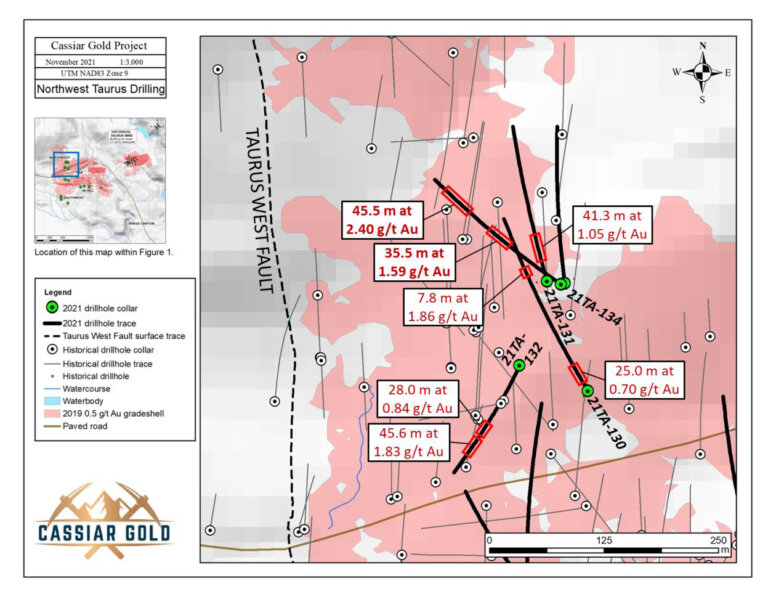Cassiar Gold has released the assay results from four of 15 diamond holes drilled at the bulk-tonnage Taurus Deposit, part of the Cassiar North property in Northern British Columbia.
The company reports results to confirm the presence of continuous zones of higher-grade, shallow (less than 200m vertical depth) gold mineralization in the Northwest Zone of the Taurus Deposit (see Exhibit 1 and 2).
The Taurus Deposit hosts a near-surface, bulk-tonnage inferred gold resource of one-million ounces grading 1.43 grams per tonne (g/t) gold.
Exhibit 1. Location Map of the Cassiar Gold Property in British Columbia, Canada

Source: Cassiar Gold Corp.
Exhibit 2. Plan Map of the Cassiar Gold Property Showing Priority Exploration Targets

Source: Cassiar Gold Corp.
Cassiar reports drill hole 21TA-134 intersected 45.5m grading2.40g/t gold from 172.9 to 218.4m downhole, including 13.9m at 3.76g/t gold and 35.5m at 1.59g/t gold between 98.21 and 133.7m downhole.
Drillhole 21TA-132 intersected 45.6m grading 1.83g/t gold from 180.1 to 225.7m downhole.
Drillhole 21TA-130 intersected 7.8m grading 1.86 g/t gold from 200.3 to 208.2m downhole and 5.3m at 2.75g/t gold from 133.0 to 138.2m downhole, including 0.6m at 16.50g/t gold.
Drillhole 21TA-131 intersected 41.3m of 1.05g/t gold from 24.7m to 66m downhole.
The Significance
The 2021 Cassiar North drill program focused on the Taurus Deposit. The program consisted of 15 drill holes totalling 4,098m, completed from early June to mid-August (see Exhibit 3).
Exhibit 3. Plan Map Showing Priority Taurus Drill Targets

Source: Cassiar Gold Corp.
The drill program targeted the 88 Hill, Gap, Southwest and Northwest Zones of the resource. The aim was to upgrade existing resources by defining higher-grade mineralized areas where historical drill holes are widely spaced at about 100m spacing.
The resource remains open in all directions, and additional target areas are being reviewed for further advancement in upcoming drill programs.
The four drill holes targeted the east side, hanging wall, of the moderately east-dipping Taurus West Fault, which is interpreted to be a reactivated structure with an early shear zone overprinted by later brittle movement.
Mineralization in the Northwest Zone appears to have a northerly trend parallel to the fault, which contrasts with the dominantly westerly trend of mineralization through the central portion of the Taurus Deposit. Therefore, the four drill holes were designed to test both the northerly and westerly mineralization trends in this area (see Exhibit 4).
Exhibit 4. Highlights of 2021 Intersections from the Northwest Zone of the Taurus Resource Area. The Surface Projection of 2019, 0.5g/t Gold Grade Shell is Shown for Reference.

Source: Cassiar Gold Corp.
Overall, drilling at the Northwest Zone has shown continuous shallow (<200 m depth) gold mineralization with composite grades consistently above the overall Taurus resource grade of 1.43g/t gold.
West-trending mineralization in the central portion of the resource is observed to balloon and join with the north-trending mineralized areas at the Northwest Zone. This creates broad zones of continuous, disseminated pyrite and quartz veinlet-hosted mineralization in quartz-carbonate-altered basalt host rock on the east side of the fault.
Cassiar interprets these results to support the potential to increase the resource base, both by further definition of continuous gold mineralization and by expanding this higher-grade corridor. The corridor remains open along strike beyond the known resource footprint to the north and the south.
For complete information on Cassiar Gold, please visit the corporate website at cassiargold.com.
Next Steps
The company completed the 2021 drill campaign on November 1 and is currently demobilizing from site in preparation for the seasonal shutdown.
A total of 34 holes drilled 11,288m during the program, including 15 holes of 4,098m within or close to the Taurus Deposit at Cassiar North and 19 holes over 7,000m targeting high-grade vein systems at Cassiar South.
At Cassiar North, additional assay profiles for partial and complete holes are pending and will be released as they are received and reviewed.
At Cassiar South, results remain pending for holes that have been completed at East Bain, Cusac, Hot, and Vollaug veins.
Company Highlights
- Cassiar holds projects in two important Orogenic Gold Districts in British Columbia
- Flagship Cassiar Gold project in Northern BC
- 100% owned 59,000 ha property with +15km strike of gold targets
- Site of historic Cassiar placer gold rush from 1874-95 which produced more than 74,000 oz of placer gold
- Cassiar North hosts an NI 43-101 Inferred Resource Estimate of +1Moz gold grading, on average, 1.43 g/t with significant resource expansion potential
- Cassiar South hosts multiple, high grade (+15 g/t gold) vein targets with access from 25km of underground workings; past production of about 315,000oz from 1979-97
- Excellent infrastructure with permitted 300 t/d mill (gravity/flotation), Highway 37, property access roads, permanent camp, water
- Sheep Creek in Southeast British Columbia
- 3rd largest past-producing Orogenic Gold District in BC
- Historical gold production (1899-1951) of almost 800,000 oz gold grading on average 4g/t
- Excellent exploration potential
- Experienced leadership team
- $5.6M in cash (as of Nov 15, 2021)
- Potential M&A target in a highly supportive mining jurisdiction in Northern BC, Canada






